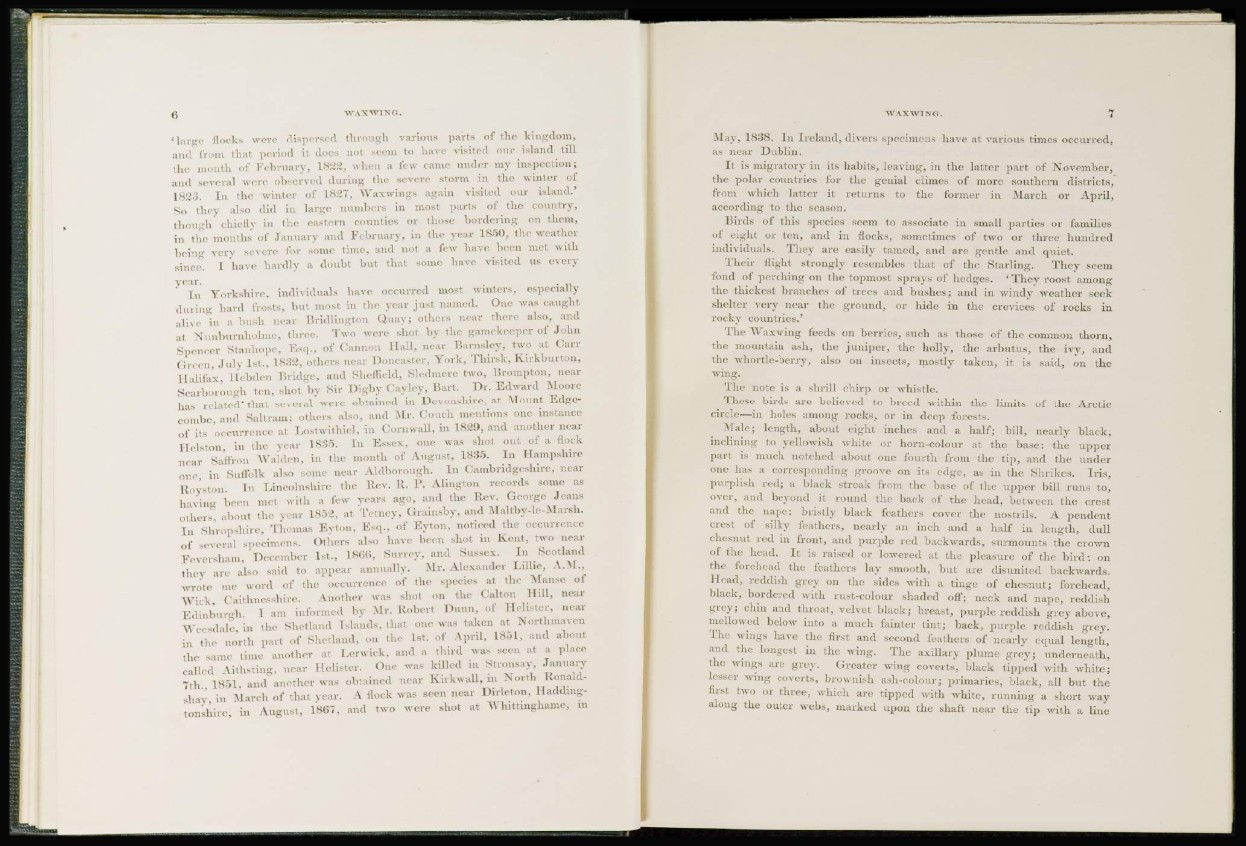
Marge flocks were dispersed through various parts of the kingdom,
and from that period it does not seem to have visited our island till
the month of February, 1822, when a few came under my inspection;
and several were observed during the severe storm in the winter of
1823. In the winter of 1827, Waxwings again visited our island.'
So they also did in large numbers in most parts of the country*
though chiefly in the eastern counties or those bordering on them,
in the months of January and February, in the year 1860, the weather
being very severe for some time, and no1 a few have been met with
since. I have hardly a doubt but that some have visited us every
year.
In Yorkshire, individuals have occurred most winters, especially
during hard frosts, but most in the year just named. One was caught
alive in a bush near Bridlington Quay; others near there also, and
at Nunburnboliue, three. Two were shot by the gamekeeper of John
Spencer Stanhope, Esq., of Cannon Hall, near Barnsley, two at Carr
Green, July 1st., 1832, others near Doncaster, York, Thirsk, Kirkburton,
Halifax, Hebden Bridge, and Sheffield, Sledmere two, Brompton, near
Scarborough ten, shot by Sir Digby Caylcy, Bart Dr. Edward Moore
has related* that several were obtained in Devonshire, at Mount Edgecombe,
ami Saltram; others also, and Mr. ('ouch mentions one instance
of its occurrence at Lostwithiel, in Cornwall, in 1829, and another near
Helston, in the year 1835. In Essex, one was shot out of a flock
near Saffron "Walden, in the month of August, 1835. In Hampshire
one, in Suffolk also some near Aldborough. In Cambridgeshire, near
Royston. In Lincolnshire the Rev. K. ] \ Alington records some as
having been met with a few years ago, and the Rev. George Jeans
others, about the year 185&, at Tctuey, Grainsby, and Maltby-le-Marsh.
In Shropshire, Thomas Eyton, Esq., of Eyton, noticed the occurrence
of several specimens. Others also have been shot in Kent, two near
Feversham, December 1st., 1866, Surrey, and Sussex. In Scotland
they are also said to appear annually. Mr. Alexander Lillie, A.M.,
wrote uie word of the occurrence of the species at the Manse of
Wick, Caithnesshire. Another was shot on the Calton Hill, near
Edinburgh. I am informed by Mr. Robert Dunn, of Heli-ter. near
Weesdale, in the Shetland Islands, that one was taken at Nortbmaven
in the north part of Shetland, on the 1st. of April, 1851, and about
the same time another at Lerwick, and a third was seen at a place
called Aithsting, near Helister. One was killed in Stronsay, January
7th.. 1851, and another was obtained near Kirkwall, in North Ronaldshay,
in March of that year. A flock was seen near Dirleton, Haddingtonshire,
in August, 1807, and two were shot at "Whittinghame, in
WAX WING. 7
May, 1838. In Ireland, divers specimens have at various times occurred,
as near Dublin.
It is migratory in its habits, leaving, in the latter part of November,
the polar countries for the genial climes of more southern districts,
from which latter it returns to the former in March or April,
according to the season.
Birds of this species seem to associate in small parties or families
of eight or ten, and in flocks, sometimes of two or three hundred
individuals, Thej are easily tamed, and are gentle and quiet.
Their flight strongly resembles that of the Starling. They seem
fond of perching on the topmost sprays of hedges. 'They roost among
the thickest branches of trees and bushes; and in windy weather seek
shelter very near the ground, or hide in the crevices of rocks in
rocky countries.'
The TVaxwing feeds on berries, such as those of the common thorn,
the mountain ash, the juniper, the holly, the arbutus, the ivy, and
the whortle-berry, also on insects, mostly taken, it is said, on the
wing.
The note is a shrill chirp or whistle.
These birds are believed to breed within the limits of the Arctic
circle—in holes among rocks, or in deep forests.
Male; length, about eight inches and a half; bill, nearly black,
inclining to yellowish white or horn-colour at the base: the upper
part is much notched about one fourth from the tip, and the under
one has a corresponding groove on its edge, as in the Shrikes. Iris,
purplish red; a black streak from the base of the upper bill runs to,
over, and beyond it round the back of the head, between the crest
and the nape: bristly black feathers cover the nostrils. A pendent
crest of silky feathers, nearly an inch and a half in length, dull
chesnut red in front, and purple red backwards, surmounts the crown
of the head. It is raised or lowered at the pleasure of the bird: on
the forehead the feathers lay smooth, but are disunited backwards.
Head, reddish grey on the sides, with a tinge of chesnut; forehead,
black, bordered with rust-colour shaded off; neck and nape, reddish
grey; chin and throat, velvet black; breast, purple reddish grey above,
mellowed below into a much fainter tint; back, purple reddish grey.
The wings have the first and second feathers of nearly equal length,
and the longest in the wing. The axillary plume grey; underneath,
the wings are grey. Greater wing coverts, black tipped with white;
lesser wing coverts, brownish ash-colour; primaries, black, all but the
first two or three, which are tipped with white, running a short way
along the outer webs, marked upon the shaft near the tip with a line